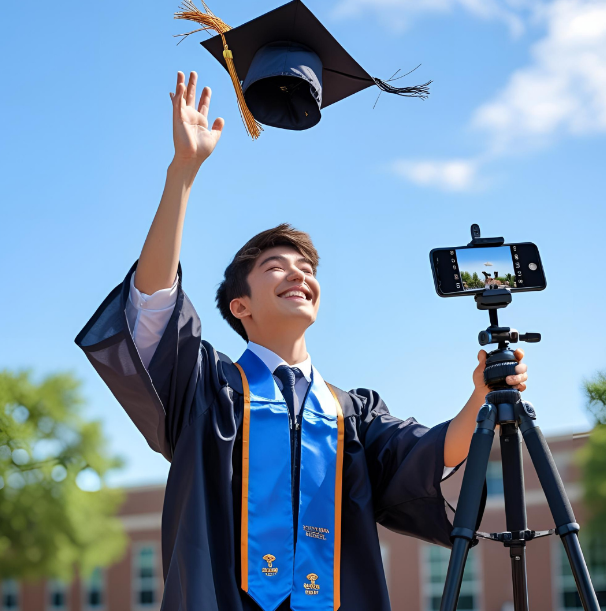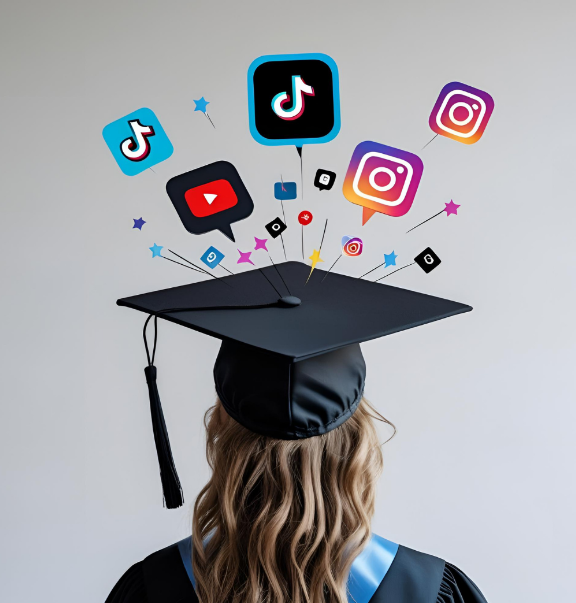A 2021 YouGov survey reveals a striking shift in career aspirations: “influencer” now ranks as the top dream job for teenagers, with over half of Gen Z viewing streaming as a legitimate full-time career path. While previous generations aspired to become doctors, lawyers, or engineers, today’s students are trading classroom seats for camera lights and lecture halls for live streams.
This fundamental transformation in career preferences signals more than just a trend—it represents a complete reimagining of what success looks like in the digital age, affecting students, educators, and parents worldwide.
What Makes the Influencer Path So Irresistible
Three core advantages drive this appeal, beginning with the most immediate motivator:
Quick Income Streams and Financial Appeal
The allure of immediate monetisation draws students toward influencer careers. Unlike traditional professions that require years of education before earning potential, content creation offers multiple revenue streams from day one. Brand partnerships, sponsored content, affiliate marketing, and direct sales through merchandise create diverse income opportunities that can generate substantial returns quickly.

Top-tier influencers command anywhere from $10,000 to $100,000 per sponsored post, figures that often exceed what many traditional professionals earn annually. For students exploring alternative income streams, side hustles for students like influencing have become especially appealing, given the potential earnings.
This stark financial contrast makes the influencer path particularly attractive to students facing uncertain economic futures.
Creative Freedom and Self-Expression
The digital platform provides unprecedented creative autonomy that traditional career paths rarely offer. Students can explore their passions, build personal brands around their interests, and connect with like-minded communities globally. This level of creative control fosters entrepreneurial thinking, allowing young people to turn their hobbies into profitable ventures.
The ability to dictate content style, presentation format, and brand messaging appeals to a generation that values authenticity and personal expression over corporate conformity.
Flexibility in Schedule and Location
Location independence and flexible scheduling represent major advantages of influencer careers. Students can work from anywhere with internet access, set their own hours, and maintain better work-life integration compared to traditional 9-to-5 employment structures.
This flexibility particularly appeals to young people who prioritise experiences over traditional career stability, allowing them to travel, pursue other interests, and maintain control over their professional lives.
What Are the Limitations of Traditional Education
Multiple systemic issues undermine its value proposition, most critically:
Rising Tuition Costs and Student Debt
Traditional higher education faces a significant cost-benefit crisis. The average annual cost for a four-year public institution exceeds $26,000, accumulating to over $104,000 for a complete degree. Private institutions demand even higher investments, often leaving graduates with substantial debt burdens that impact career choices and life decisions for decades.
Student loan debt affects 56% of public sector employees and 62% of private sector employees in their job acceptance and retention decisions, creating long-term financial stress that influences career advancement and personal satisfaction.
Elon Musk captures Gen Z’s disappointment with education…
“College is basically for fun and not for learning… You don’t need college to learn stuff” (2014 interview).
His view reflects their pragmatic question: Why spend years and $100K+ on rigid courses when skills come from creating content online?
Curriculum Rigidity vs. Real-World Skills
Higher education institutions struggle to keep pace with rapidly evolving industry demands. Traditional curricula often emphasise theoretical knowledge over practical, immediately applicable skills that employers seek in the modern workforce.
Students frequently graduate feeling unprepared for real-world challenges, lacking hands-on experience in digital marketing, social media strategy, content creation, and other skills that drive today’s economy. This skills gap makes alternative education paths more appealing to career-focused students.
Time-to-Market: Years in College vs. Instant Content Creation
The lengthy commitment required for traditional degrees conflicts with the instant gratification culture that shapes young people’s expectations. While college degrees require four or more years of study before career entry, successful content creators can build audiences and generate income within months of starting.
This time differential becomes particularly significant when students observe peers achieving financial success and recognition through digital platforms while they remain in classrooms, accumulating debt without immediate returns.
What Are the Key Drivers Behind the Shift?
Three interconnected forces amplify this transition, starting with:
Social Proof: Peers Succeeding Online
Success stories of young influencers achieving wealth and fame through social media provide powerful motivation for students considering similar paths. Examples like tech YouTubers building million-dollar businesses or street vendors becoming luxury car owners through viral content create compelling narratives that traditional career paths struggle to match.

These visible success stories generate aspirational motivation and demonstrate tangible possibilities that feel more achievable than distant professional goals requiring extensive education and experience.
Low Barrier to Entry
The accessibility of content creation tools democratizes opportunity in ways traditional careers cannot match. A smartphone and internet connection provide everything needed to start building an online presence, eliminating geographical, financial, and institutional barriers that limit access to traditional career paths.
This low entry threshold allows students to experiment with content creation while maintaining other commitments, reducing risk compared to full-time educational investments.
Platforms That Reward Virality Over Credentials
Social media algorithms prioritise engagement and creativity over formal qualifications, creating meritocracies based on content quality and audience connection rather than educational credentials. This system appeals to students who feel constrained by traditional academic assessment methods.
Platform reward structures favour innovative thinking, audience understanding, and creative execution—skills that don’t necessarily correlate with academic performance but drive real-world success in digital environments.
Risks and Challenges of Influencer Marketing
Let’s understand the pros and cons of Influencer Marketing
| Pros | Cons |
|---|---|
| Creative freedom and self-expression | Unpredictable income and financial instability |
| Flexible schedule and location independence | Mental health pressures from public scrutiny |
| Multiple monetisation opportunities | Algorithm dependency and platform changes |
| Direct audience connection and community building | Lack of traditional employment benefits |
| Potential for high earnings | Oversaturated market competition |
| Entrepreneurial skill development | Privacy concerns and work-life boundary issues |
Income Instability and Algorithm Changes
Despite the potential for high earnings, influencer income remains highly unpredictable. Platform algorithm changes can dramatically reduce visibility and revenue without warning, creating financial insecurity that traditional employment typically avoids.
Most content creators earn less than $15,000 annually, with only a small percentage achieving the high-income levels that attract students to the field. This income volatility requires careful financial planning and diversification strategies that many young creators lack.
Mental Health and Public Scrutiny
Constant public exposure creates unique psychological pressures that traditional careers rarely impose. Content creators must maintain consistent online personas, handle negative feedback and criticism, and manage the stress of performance metrics that directly impact their livelihood.
The OnlyFans refund scandal showed how sudden platform changes can harm creator income and trust, reminding student-influencers to prioritise transparency and secure payment methods with their audience.
Many students are choosing influencer careers over traditional college paths due to the flexibility and income potential offered by platforms like OnlyFans and TikTok. One important aspect of sustaining this career is managing OnlyFans refund requests, which requires creators to understand platform policies and maintain clear communication with subscribers. Being prepared for these responsibilities helps student influencers protect their earnings and build a trustworthy online presence.
Research indicates that excessive social media engagement increases risks for depression, anxiety, and body dissatisfaction, particularly among young people whose self-worth becomes tied to online validation metrics.
Lack of Formal Qualifications if Plan B is Needed
Pursuing influencer careers without formal education creates challenges if alternative career paths become necessary. Traditional employers may not recognise content creation experience as a valuable professional background, limiting options if digital careers don’t succeed.
The absence of formal qualifications can restrict access to backup career opportunities, creating long-term professional vulnerability that becomes problematic if influencer careers fail to provide sustainable income.
Balancing Both Worlds
If you want, you can balance both words with ease:
Hybrid Models: Part-Time Courses + Content Creation
Students can pursue hybrid approaches that combine traditional education with content creation experience. Part-time enrollment allows continued learning while building online presence, creating safety nets without abandoning digital opportunities.
This balanced approach provides formal qualifications while developing practical skills in digital marketing, audience engagement, and entrepreneurship that enhance both traditional and alternative career prospects.
Micro-Credentials and Bootcamps Focused on Digital Skills
Alternative education options, such as boot camps, online certifications, and micro-credentials, offer targeted skill development without the time and cost commitments associated with traditional degrees. These programs focus on immediately applicable abilities that support both influencer careers and traditional employment.
Digital marketing certifications, social media strategy courses, and content creation workshops provide structured learning that bridges the gap between formal education and practical industry needs.
Tips for Time Management and Goal-Setting
Successful integration of education and content creation requires strategic time management and clear goal setting. Students should establish specific objectives for both academic performance and content development, allocating time proportionally based on long-term career priorities.
Creating content calendars, maintaining consistent study schedules, and setting measurable milestones for both educational and digital achievements helps maintain progress in multiple areas without compromising either pursuit.
Also Checkout:
Final Verdict: Start Creating Content Today—It’s Gen Z’s Ultimate Career Accelerator, But Pair It With Education For Lasting Success
As Gen Z to Gen Z: Start creating content now. It’s not about dropping out—it’s about building real-world skills while you learn. Content creation develops communication, marketing, and entrepreneurial instincts that amplify ANY career. But pair it with education: Formal learning provides safety nets and depth that digital platforms can’t.
Like a coin, everything has two sides with pros and cons—it’s up to you how and what you do with it.
The choice between traditional education and influencer careers isn’t necessarily binary. The most successful approach often involves a strategic combination rather than complete abandonment of either path. Content creation develops communication skills, marketing understanding, audience psychology, and entrepreneurial thinking that benefit any career direction you choose.
FAQs
While some influencers earn substantial income, most content creators make less than $15,000 annually. Success requires consistent effort, business skills, and often takes years to achieve sustainable income levels.
Consider hybrid approaches that allow content creation while maintaining educational progress. Complete abandonment of formal education eliminates important backup options and foundational skills.
Content creation, social media strategy, basic business and marketing knowledge, video editing, audience engagement, and financial management are essential for sustainable influencer careers.
Building a substantial following and achieving financial stability typically requires 2-5 years of consistent effort, though some achieve success faster through viral content or unique positioning.
Income instability, mental health pressures, platform dependency, lack of traditional qualifications, and limited career alternatives represent the primary risks of influencer-focused career paths.
- Top 5 Online Sports Courses to Boost Your Skills in 2025 - September 29, 2025
- Top 10 Free Plagiarism Checker Tools in 2025 (Try Now) - August 22, 2025
- Quillbot Free Trial 2025 – Access Without Limits - August 20, 2025
